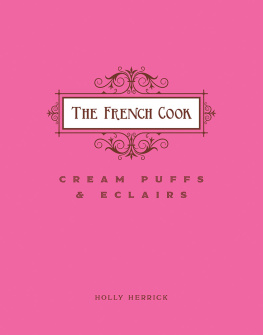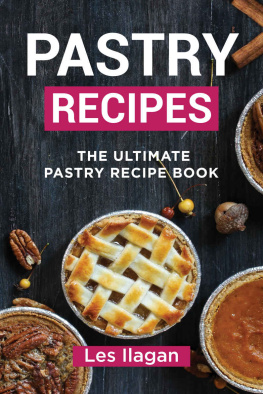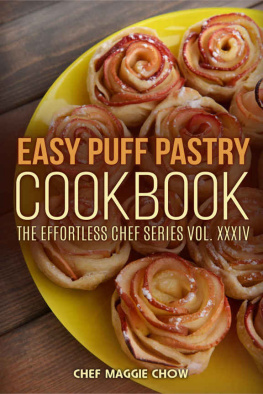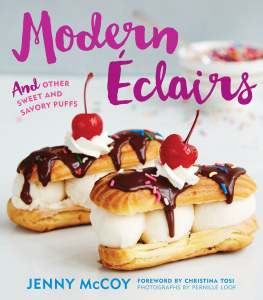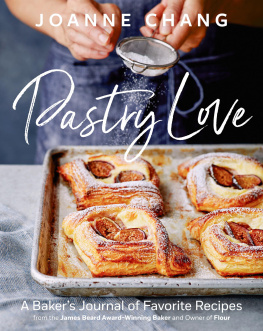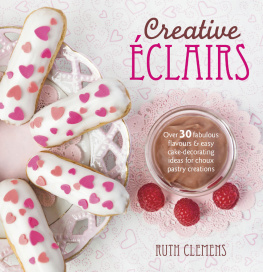FRENCH
PASTRY
101
Learn the Art of Classic Baking with 60 Beginner-Friendly Recipes
Betty Hung
Owner of Beaucoup Bakery

The author and publisher have provided this e-book to you for your personal use only. You may not make this e-book publicly available in any way. Copyright infringement is against the law. If you believe the copy of this e-book you are reading infringes on the authors copyright, please notify the publisher at: http://us.macmillanusa.com/piracy.
For the passionate, curious and adventurous home bakers.
For my family, who would always eat anything I baked.
For my 10-year-old self, who first found so much joy in baking.

When I was still a home baker, French pastries fascinated me. How could such humble ingredients turn into something so complex and delicious? Many baking techniques as we know them have French rootsI discovered this when I started my pastry apprenticeship. As I immersed myself into the world of ptisserie, I learned that French pastries are not just about the techniques and ingredients; they are also about precision, temperature, time and the smallest details that make the biggest difference. All of the ingredients in these recipes are provided in volume and weight in grams. I find that measuring in grams yields the most accurate and consistent results. I recommend using a scale to measure all your ingredients, if possible. Making French pastries may seem intimidating to the average home baker. I have baked all the recipes in this book in my home using as few special ingredients and equipment as possible while achieving delicious results. I hope to share some tips and tricks to help any home baker become more confident in their baking projects. Most recipes in this book are meant for beginners, and when you build up your confidence, you can even try to tackle the few advanced recipes!


These are some of the fundamental recipes for French pastries. For starters, learning these will lay the foundation for some of the more difficult recipes. One recipe I often revisit is is indispensible when it comes to French pastries; its used to fill anything from choux puffs to a mille-feuille.
The Creaming Method for Making Pte Sucre and Sabls
To have a good foundation for any pastry, you need to learn the basic techniques for making butter-based doughs using the creaming method. A good example is the in the Cookies chapter.
To start, make sure your butter is at a good temperature. Cold butter will result in hard chunks in the dough that will melt out as it bakes. If the butter is too soft (as soft as mayonnaise), youll incorporate too much air in the dough, and it may crumble when you roll it out. The butter is at the perfect temperature when it is soft yet pliable; if you pressed it down with your finger, it should leave a clean dent yet shouldnt stick to your finger.
When creaming the butter and sugar, use the paddle attachment if you are using a stand mixer. Cream it for about 2 minutes at low speed just until the sugar and butter are well incorporated. The key here is not incorporating too much air as mentioned above. When beating in the egg, make sure it is well combined and that the side of the bowl is scraped to ensure all the ingredients are well distributed. After adding the flour, avoid over-mixing the dough. You want to mix it just until there is no more dryness. You can finish mixing by kneading the dough 2 to 3 times with your hands on the counter. Over-mixing will make the gluten bonds stronger, therefore the final product will shrink more and become tough.
It is generally recommended that this type of dough rest in the fridge for 2 to 3 hours or overnight before proceeding. The gluten bonds will relax and the dough becomes easier to roll out and more tender. The sugar will also fully dissolve and result in a more even color after baking.

Prep Time: 20 minutes - Makes 1 cup (480 g)
This vanilla pastry cream is a versatile filling used in many French pastries such as tarts, clairs, mille-feuille and more. This recipe is thickened with cornstarch, though some use flour. You can easily infuse other flavors when warming the milk by adding tea leaves and spices. I love using strong teas like English Breakfast or Earl Grey because they give the pastry cream a rich flavor. You can make a spiced pastry cream by infusing a cinnamon stick and a few cardamom pods while warming the milk. This is used in many recipes, such as .
1 cups (300 g) whole milk
2 tbsp + 1 tbsp (52 g) granulated sugar, divided
vanilla bean, split and seeds scraped
4 egg yolks
3 tbsp (25 g) cornstarch
A pinch of salt
2 tbsp (30 g) unsalted butter, softened
In a small saucepan, heat the milk on medium heat with 2 tablespoons (30 g) of sugar and the vanilla bean and its seeds until it starts to simmer, about 3 minutes. Turn off the heat, cover the pot and let it steep while you prepare the egg portion of the recipe.
In a medium bowl, whisk together the egg yolks, the remaining sugar, cornstarch and salt. Slowly pour in the hot milk while whisking the egg mixture. Return the mixture to the pot, and turn the heat back on to medium-low. Keep whisking the mixture to keep it from burning on the bottom of the pot, for about 3 to 4 minutes. The pastry cream will start to thicken, and when it starts to boil, it is ready.
Take the pot off the heat, whisk in the butter and strain the cream into a clean bowl. It will be thick, so use a spatula to push it through the strainer. This is to remove the vanilla pod and any impurities such as egg shells. Place a piece of plastic wrap directly onto the surface of the pastry cream to prevent a skin from forming, cool it and store it in the fridge. This can be made up to 3 days in advance.
Tip: This recipe makes a relatively small amount, so it cooks very quickly. Keep whisking the pastry cream as you are cooking to avoid burning it.

Prep Time: 15 minutes - Makes 2 cups (280 g)
Crme Chantilly may sound fancy, but it is simply whipped cream. However, we often neglect it and over-whip it so its not enjoyed at its perfect texture. For small batches like this, I like to whip it by hand because there is less chance of over-whipping. Be sure to use a heavy cream or whipping cream. This is used in many recipes such as .
1 cup (250 g) heavy cream or whipping cream
2 tbsp (30 g) granulated sugar


